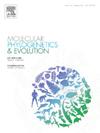破译高山野菜科(芸苔科)物种形成的驱动因素揭示了一个主要由地理塑造的进化。
IF 3.6
1区 生物学
Q2 BIOCHEMISTRY & MOLECULAR BIOLOGY
引用次数: 0
摘要
物种划界的过程被定义为识别生物学上有意义的分类单位的行为,可以检测整体生物多样性和探索物种形成过程。鉴于生物多样性起源的复杂性,大量的高山植物类群在其系统发育关系和物种界限方面表现出模糊性。在这项研究中,我们试图将综合分类学的原理应用于一个复杂的高山隐生植物Noccaea属,这些植物通常被描述为基质专家。我们受益于跨越阿尔卑斯山的广泛采样,结合高通量基因分型,应用现代和标准化的物种划分方法。研究发现,在阿尔卑斯地区,圆叶nocaea复合体仅以5种为代表,其地理分布有限。其中四个物种大约在350 ka前(259-429)分化,表明最近的多样化。与现有分类学对不同底物亲和度的物种进行识别不同,我们发现分布最广的物种是底物通用性物种,但具有异域分布。我们的研究结果表明,圆叶菊只生长在著名的奥斯塔山谷生物地理屏障的西部。N. corymbosa被发现生长在奥斯塔山谷屏障和科莫湖屏障之间。而在阿尔卑斯山脉东部,被布伦纳山谷隔开,可以观察到北凤头莲。总体而言,本研究提供了一个详细的系统回顾,支持公认的高山生物地理屏障在形成物种分布和物种形成中的关键作用。本文章由计算机程序翻译,如有差异,请以英文原文为准。

Deciphering the drivers of speciation in Alpine Noccaea (Brassicaceae) reveal an evolution predominantly shaped by geography
The process of species delimitation, defined as the act of recognising biologically meaningful taxonomic units, enables the detection of overall biodiversity and the exploration of speciation processes. Given the complex nature of the origin of biodiversity, a significant number of cryptic Alpine plant groups exhibit ambiguity regarding their phylogenetic relationships and species circumscription. In this study, we attempt to apply the principles of integrative taxonomy to a complex of cryptic alpine plants from the genus Noccaea, which are often described as substrate specialists. We benefited from an extensive sampling across the Alps combined with high-throughput genotyping to apply a modern and standardised method of species delimitation. We find that the Noccaea rotundifolia complex is represented by five species within the Alps, which exhibit a restricted geographic distribution. Four of these species diverged approximately 350 ka ago (259–429), indicating a recent diversification. Instead of recognizing species with different substrate affinities, as done by current taxonomy, we rather find that the most widespread species are substrate generalists but with allopatric distributions. Our findings indicate that N. rotundifolia is growing exclusively in the west of the well-known biogeographic barrier of the Aosta Valley. N. corymbosa is found to grow between the Aosta Valley barrier and the Lake Como one. N. cepaeifolia, in turn, is observed in the eastern Alps, separated by the Brenner valley. Overall, this study provides a detailed systematic review, supporting the pivotal role of the recognized Alpine biogeographic barriers, in shaping species distribution and speciation.
求助全文
通过发布文献求助,成功后即可免费获取论文全文。
去求助
来源期刊
CiteScore
7.50
自引率
7.30%
发文量
249
审稿时长
7.5 months
期刊介绍:
Molecular Phylogenetics and Evolution is dedicated to bringing Darwin''s dream within grasp - to "have fairly true genealogical trees of each great kingdom of Nature." The journal provides a forum for molecular studies that advance our understanding of phylogeny and evolution, further the development of phylogenetically more accurate taxonomic classifications, and ultimately bring a unified classification for all the ramifying lines of life. Phylogeographic studies will be considered for publication if they offer EXCEPTIONAL theoretical or empirical advances.

 求助内容:
求助内容: 应助结果提醒方式:
应助结果提醒方式:


